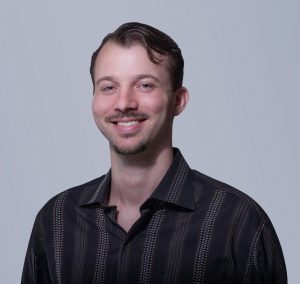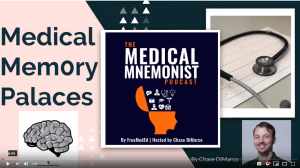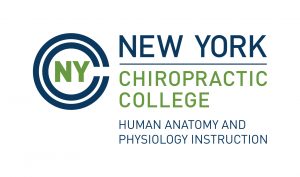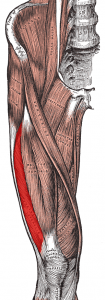Mar 16, 2020
Host Kevin Patton chats with mnemonist (memory expert) Chase DiMarco, who helps medical students learn. DiMarco describes how to use memory palaces in learning human anatomy and physiology.
00:44 | Introducing
Chase DiMarco
02:33 | Sponsored by AAA (Silverthorn toast)
03:53 | What Is a Memory Palace?
11:44 | Sponsored by HAPI
12:07 | Building a Memory Palace
22:53 | Sponsored by HAPS
23:16 | Helping our Students
27:51 | Staying Connected
If you cannot see or activate the
audio player click here.
Please take the anonymous survey: theAPprofessor.org/survey
Questions & Feedback: 1-833-LION-DEN
(1-833-546-6336)
Follow The A&P Professor on Twitter, Facebook,
Blogger,
Nuzzel,
Tumblr, or
Instagram!
Memory is the treasury and guardian of all things. (Marcus Tullius Cicero)
Introducing Chase DiMarco
2 minutes
Chase DiMarco is memory expert (mnemonist), medical education entrepreneur, MBA, and MD-PhD candidate. He specializes in helping medical and health sciences students succeed in learning and remembering large amounts of information in a short time. Which is what these students need, right?
- Founder of FreeMedEd
- Host of Medical Mnemonist Podcast
- Host of 1-Minute Preceptor Podcast
- Social media:
- Faculty can book a one-on-one chat with Chase DiMarco at
- Students or faculty can get personalized tutoring at
- Read This Before Medical School: How to Study Smarter and Live
Better While Excelling in Class and on your USMLE or COMLEX Board
Exams
- Chase DiMarco's book
- amzn.to/2ThbBwv
- Reviewed by Kevin Patton at
- Book Club for Anatomy & Physiology Professors
- Episode 64 Preview (book club segment) theAPprofessor.org/64#pre
Sponsored by AAA
1.5 minutes
A searchable transcript for this episode, as well as the captioned audiogram of this episode, are sponsored by the American Association for Anatomy (AAA) at anatomy.org.
Don't forget—HAPS members get a deep discount on AAA membership!
A toast:
- Congratulations 🥂 to Dee Silverthorn's induction as a Fellow of the American Association of Anatomy (FAAA)!
- And to ALL the new members of the Fellows Circle!
- my-ap.us/2T2BOjo
What Is a Memory Palace?
8 minutes
A "memory palace" is a mnemonic device or technique in which a learner imagines a location such as a house or room and places concepts or terms to be remembered at specific locations within it. This helps a person remember a large group of things by remembering their location in the imagined location.
This technique is also called "method of loci"—and bunch of other synonyms that one would need a memory palace to remember.
- Memory Palaces for Medicine (video tutorial on how to use the technique)
- Podcast episodes of interest:
- Blog post:
Sponsored by HAPI Online Graduate Program
0.5 minute
The Master of Science in Human Anatomy & Physiology Instruction—the MS-HAPI—is a graduate program for A&P teachers. A combination of science courses (enough to qualify you to teach at the college level) and courses in contemporary instructional practice, this program helps you power up your teaching. Kevin Patton is a faculty member in this program. Check it out!
Building a Memory Palace
11 minutes
Memory palaces are one of the tools in the toolbox that we can offer our A&P students. This one takes Practice. Practice. Practice. —but can really pay off in increased retention and retrieval!
Sponsored by HAPS
0.5 minutes
The Human Anatomy & Physiology Society (HAPS) is a sponsor of this podcast. You can help appreciate their support by clicking the link below and checking out the many resources and benefits found there. Don't forget the HAPS Awards, which provide assistance for participating in the HAPS Annual Conference.
It's coming soon! 🤗
Kevin’s Unofficial Guide to the HAPS Annual Conference | 2019 Edition | Episode 42
LAST CALL! Now is a good time to submit your questions, comments, tips, & stories for the upcoming 2020 edition!
Survey Says...
0.5 minute
Please take about 5 minutes to answer some questions—it will really help improve this podcast!
Yes; I'll give you extra credit if you fill out a survey!
If the hyperlinks here are not active, go to TAPPradio.org to find the episode page.
- More details at the episode page.
- Transcript available in the transcript box.
- Listen to any episode on your Alexa device.
- Need help accessing resources locked behind a paywall? Check out this advice from Episode 32 to get what you need! https://youtu.be/JU_l76JGwVw?t=440











